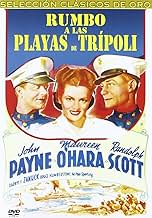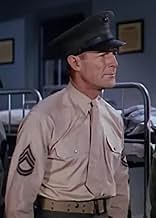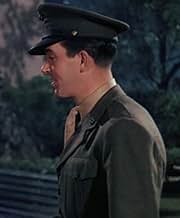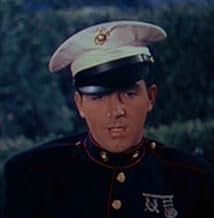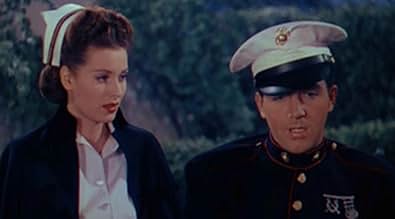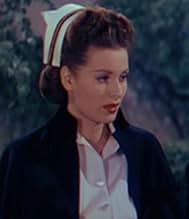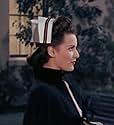IMDb-BEWERTUNG
6,0/10
1057
IHRE BEWERTUNG
Füge eine Handlung in deiner Sprache hinzuLife at the Marine Training Base in San Diego on the eve of the Japanese attack on Pearl Harbor.Life at the Marine Training Base in San Diego on the eve of the Japanese attack on Pearl Harbor.Life at the Marine Training Base in San Diego on the eve of the Japanese attack on Pearl Harbor.
- Regie
- Drehbuch
- Hauptbesetzung
- Für 1 Oscar nominiert
- 1 Gewinn & 1 Nominierung insgesamt
Harry Morgan
- Mouthy
- (as Henry Morgan)
Joseph Crehan
- Uncle Bob
- (Gelöschte Szenen)
John Hamilton
- Gen. Gordon
- (Gelöschte Szenen)
Iris Adrian
- Okay's Girlfriend
- (Nicht genannt)
Stanley Andrews
- Doctor
- (Nicht genannt)
Hugh Beaumont
- Orderly
- (Nicht genannt)
Empfohlene Bewertungen
After watching this movie, I now know where the "Officer and a Gentleman" screen writers probably got their idea for the character Sgt. Foley. Randolph Scott was the Sgt. Foley of the 1940s. This movie was made during World War Two, but it spares us the jingoistic propaganda associated with most war movies of that era and offers interesting and likable characters, especially Maureen O'Hara as a Navy nurse and John Payne as the recruit. While watching this movie I thought of Richard Gere and how he would have fit in well in this movie. The similarities between this movie and "Officer" must be more than just coincidental. "Officer" was more intense but this movie did not need to rely on such theatrics to maintain audience interest because the star of this movie was the USMC itself.
The plot of "To the Shores of Tripoli" is very, very similar to the very popular "Buck Privates" starring Bud Abbott and Lou Costello. But, unlike this film from the year before, "To the Shores of Tripoli" is not meant to be a comedy. Like the earlier film, this one starts with an obnoxious and self-assured brat of a man (John Payne) walking into the Marine base--assuming because of his connections that he will be accorded special privileges. But, like the other film, his father goes behind his back and insists that his son needs character building and NO exceptions or special favors should be granted to him. And, like "Buck Privates", the brat manages to make a nuisance of himself until, ultimately, he finds redemption. In the interim, he relentlessly chases a pretty nurse (Maureen O'Hara), tangles repeatedly with his Sergeant and makes a few friends--then alienates them with his boorish attitude.
Overall, the film looks great. It's filmed in full color--the sort of intense 1940s color that doesn't quite look real, but is better in some ways than real life! The acting is excellent (with Payne, O'Hara and Randolph Scott) and there is a nice group of actors who play the recruits such as Harry Morgan (in his first film), "Slapsie" Maxie Rosenbloom and William Tracy (famous for his Sergeant Doubleday films with Hal Roach). As for the story, it's very predictable and formulaic throughout, but it's well-made formula! Mindless but very enjoyable wartime propaganda that must have done a lot to bolster the public behind the war effort.
Overall, the film looks great. It's filmed in full color--the sort of intense 1940s color that doesn't quite look real, but is better in some ways than real life! The acting is excellent (with Payne, O'Hara and Randolph Scott) and there is a nice group of actors who play the recruits such as Harry Morgan (in his first film), "Slapsie" Maxie Rosenbloom and William Tracy (famous for his Sergeant Doubleday films with Hal Roach). As for the story, it's very predictable and formulaic throughout, but it's well-made formula! Mindless but very enjoyable wartime propaganda that must have done a lot to bolster the public behind the war effort.
While the story line is only so-so, the list of stars is quite impressive. The really special part of this movie is the exposure that the Marines in San Diego had to so many of the stars of the day. My father's unit (he was a DI) was used to film the movie. When you see Randolph Scott drilling his men, the close-ups are of Mr. Scott - the far off shots are of my father. My father also appears as an extra in other shots - the most noticeable being the scene where the men are all sitting in the bleachers. The really memorable aspect (and hopefully not TOO sentimental) of all this centers around the fact that this is the only record I have of my father in a "moving picture" (He died in 1952 when I was 3 years old, and the only pictures I have of him are still shots).
Additionally, I fondly remember a large autographed picture by Randolph Scott inscribed to my father and the men in the unit - sitting in front of the men are Mr. Scott and my father, both wearing their round DI hats. This picture was also very special to all of us children. Therefore, this movie, while never going down as one of the great ones, will always have a very special place in my heart. It also gives me a better appreciation of movie "extras" and makes me wonder, "who are they and whatever happened to them"!
Additionally, I fondly remember a large autographed picture by Randolph Scott inscribed to my father and the men in the unit - sitting in front of the men are Mr. Scott and my father, both wearing their round DI hats. This picture was also very special to all of us children. Therefore, this movie, while never going down as one of the great ones, will always have a very special place in my heart. It also gives me a better appreciation of movie "extras" and makes me wonder, "who are they and whatever happened to them"!
Darryl Zanuck personally signed his name to this seminal, jaw-droppingly glamourous war movie full as leading lady Maureen O'Hara put it, of "unfurling flags, marching men, and martial music" and "credited with more new enlistments in the United States Marine Corps than any other promotional campaign that year". Shot at San Diego Marine Base, it also represents a key moment in film history as Miss O'Hara's first Technicolor production, for which she'd been becomingly transformed into a brunette.
While it was in production (SPOILER COMING:) Pearl Harbor was bombed (a moment when according to the movies every single American simultaneously had their radios on when the news first hit the airwaves); cue the outrageous super-patriotic climax when John Payne finally puts his love-life on hold the better to head for the Pacific.
Hirohito and Tojo probably never saw it; but Dr Goebbels probably needed oxygen after seeing this one!
While it was in production (SPOILER COMING:) Pearl Harbor was bombed (a moment when according to the movies every single American simultaneously had their radios on when the news first hit the airwaves); cue the outrageous super-patriotic climax when John Payne finally puts his love-life on hold the better to head for the Pacific.
Hirohito and Tojo probably never saw it; but Dr Goebbels probably needed oxygen after seeing this one!
PEARL HARBOR seems to have borrowed elements of its plotline from TO THE SHORES OF TRIPOLI--only this time the cocky hero with plenty of attitude is JOHN PAYNE and the Navy nurse he falls in love with is MAUREEN O'HARA. The scene where she gets even with him in the dispensary is reminiscent of the much more graphic event in PEARL HARBOR's early courtship scene.
Anyway, as patriotic flag-waving recruitment films go, this one is typical of what the public clamored for during World War II. I'm sure the stirring drill scenes and dress parade moments, combined with stirring soundtrack music, were geared to get marine enlistments into high gear. And maybe they succeeded.
Having put in some military years at the San Diego Naval base, much of the background looks achingly familiar to me. All of the location scenes at the military base have the requisite real flavor while the story itself is the timeless cliche about the spoiled rich boy who is given the rough treatment by a sergeant who wants to turn him into a tough marine. Naturally the over confident military brat becomes a hero in time to rescue his sergeant during a mine sweeping operation--and in time to ensure a happy ending for his romance with nurse O'Hara.
JOHN PAYNE is at his best as the cocky young marine, his left eyebrow getting its usual workout as he seeks to outmanouver everyone in his path. He also gets to show off his splendid physique in the scene where hot-tempered O'Hara plays a dirty trick on him. RANDOLPH SCOTT is excellent as the drill sergeant and others in the cast are up to par--including NANCY KELLY in a rather thankless assignment as "the other woman".
MAUREEN O'HARA is stunning in technicolor but, as usual, has virtually little to do aside from looking gorgeous in a number of close-ups. Her role is typical of the many innocuous cardboard heroines she had to play in the '40s.
Summing up: Nice marine recruitment film, if a bit obvious in its patriotism.
Anyway, as patriotic flag-waving recruitment films go, this one is typical of what the public clamored for during World War II. I'm sure the stirring drill scenes and dress parade moments, combined with stirring soundtrack music, were geared to get marine enlistments into high gear. And maybe they succeeded.
Having put in some military years at the San Diego Naval base, much of the background looks achingly familiar to me. All of the location scenes at the military base have the requisite real flavor while the story itself is the timeless cliche about the spoiled rich boy who is given the rough treatment by a sergeant who wants to turn him into a tough marine. Naturally the over confident military brat becomes a hero in time to rescue his sergeant during a mine sweeping operation--and in time to ensure a happy ending for his romance with nurse O'Hara.
JOHN PAYNE is at his best as the cocky young marine, his left eyebrow getting its usual workout as he seeks to outmanouver everyone in his path. He also gets to show off his splendid physique in the scene where hot-tempered O'Hara plays a dirty trick on him. RANDOLPH SCOTT is excellent as the drill sergeant and others in the cast are up to par--including NANCY KELLY in a rather thankless assignment as "the other woman".
MAUREEN O'HARA is stunning in technicolor but, as usual, has virtually little to do aside from looking gorgeous in a number of close-ups. Her role is typical of the many innocuous cardboard heroines she had to play in the '40s.
Summing up: Nice marine recruitment film, if a bit obvious in its patriotism.
Wusstest du schon
- WissenswertesMaureen O'Haras' first film in Technicolor. She looked so good in it that she later earned the nickname "Queen of Technicolor".
- PatzerIn several instances Chris Winters (John Payne) and Sgt. Smith (Randolph Scott) are shown flicking lit cigarettes away, or grinding them into the ground. This would never be allowed as Marines were taught to field strip cigarettes, spreading the ashes and tobacco and rolling the paper into a tiny ball.
- Zitate
Sgt. Dixie Smith: Good morning, Roberts.
Corporal: Good morning, Sergeant. You're up kind of early.
Sgt. Dixie Smith: Yeah, I'm expecting a guest.
Corporal: Don't tell me Cagney's coming down here to glorify the Marines again.
- VerbindungenEdited into All This and World War II (1976)
- SoundtracksI Know Why (and So Do You)
(uncredited)
Music by Harry Warren
Played at the first dance and at various times throughout the picture
Top-Auswahl
Melde dich zum Bewerten an und greife auf die Watchlist für personalisierte Empfehlungen zu.
- How long is To the Shores of Tripoli?Powered by Alexa
Details
Box Office
- Bruttoertrag in den USA und Kanada
- 2.300.000 $
- Laufzeit
- 1 Std. 26 Min.(86 min)
- Seitenverhältnis
- 1.37 : 1
Zu dieser Seite beitragen
Bearbeitung vorschlagen oder fehlenden Inhalt hinzufügen


